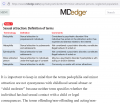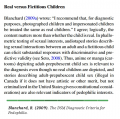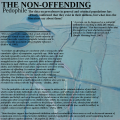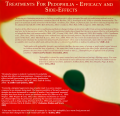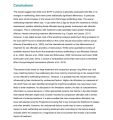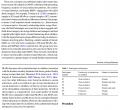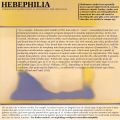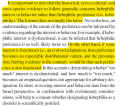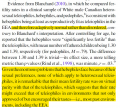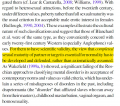One of our staff members is contributing considerably to a News Archiving service at Mu. Any well educated (Masters, PhD or above) users who wish to make comments on news sites, please contact Jim Burton directly rather than using this list, and we can work on maximising view count.
Research: Pedophilia as a sexual/erotic orientation: Difference between revisions
The Admins (talk | contribs) |
The Admins (talk | contribs) No edit summary |
||
| Line 22: | Line 22: | ||
*'''Martijn, F. et al., (2020). "[https://link.springer.com/article/10.1007/s10508-019-01579-9 Sexual Attraction and Falling in Love in Persons with Pedohebephilia]", ''Archives of Sexual Behavior'' 49, pages 1305–1318.''' | *'''Martijn, F. et al., (2020). "[https://link.springer.com/article/10.1007/s10508-019-01579-9 Sexual Attraction and Falling in Love in Persons with Pedohebephilia]", ''Archives of Sexual Behavior'' 49, pages 1305–1318.''' | ||
*:"Few studies of pedophilia or hebephilia have included questions about romantic attraction. We conducted an anonymous online survey of 306 men who self-reported as sexually attracted to children. The majority (72%) of participants reported they had fallen in love with a child in their lifetime. Participants reported greater feelings of attachment to children than feelings of infatuation. Though sexual attraction and falling in love were strongly correlated, they were not synonymous. Participants who reported pedohebephilia (defined in this study as attraction to prepubescent and pubescent children) were more likely to have fallen in love with a child than participants who reported pedohebe-ephebophilia (defined as attraction to prepubescent, pubescent, and post-pubescent minors). Also, participants with an exclusive attraction to children were more likely to have fallen in love with a child than participants who were equally attracted to children and adults. The results of this study were consistent with the suggestion of Seto (2012) that pedohebephilia could be considered a form of sexual orientation for age, which includes both sexual and romantic attraction." | *:"Few studies of pedophilia or hebephilia have included questions about romantic attraction. We conducted an anonymous online survey of 306 men who self-reported as sexually attracted to children. The majority (72%) of participants reported they had fallen in love with a child in their lifetime. Participants reported greater feelings of attachment to children than feelings of infatuation. Though sexual attraction and falling in love were strongly correlated, they were not synonymous. Participants who reported pedohebephilia (defined in this study as attraction to prepubescent and pubescent children) were more likely to have fallen in love with a child than participants who reported pedohebe-ephebophilia (defined as attraction to prepubescent, pubescent, and post-pubescent minors). Also, participants with an exclusive attraction to children were more likely to have fallen in love with a child than participants who were equally attracted to children and adults. The results of this study were consistent with the suggestion of Seto (2012) that pedohebephilia could be considered a form of sexual orientation for age, which includes both sexual and romantic attraction." | ||
*'''Chenier, E. (2011). [https://sci-hub.se/10.1007/s12119-011-9116-z "The Natural Order of Disorder: Pedophilia, Stranger Danger and the Normalising Family"]''', ''Sexuality & Culture'', 16:172–18. | |||
*:"'''Abstract:''' Over the past two decades critics have challenged the validity of pedophilia as a mental disorder and have implored us to think differently about child sexuality as well as incidences of sexual contact and intimacy between adults and children or adolescents. This growing literature provides compelling evidence against using a medical framework for understanding and responding to pedophilia, yet most people in the English-speaking world still cling to a post-World War Two construction of the pedophile as a dangerous stranger, pathologically unable to control his insatiable sexual desire for young people. This article aims to address this particular dilemma. Drawing on the work of Ann Laura Stoler, it argues that the construction of the pedophile is a vector of normalisation processes, ‘‘a tactic in the internal fission of society into binary oppositions, and means of creating ‘biologized’ internal enemies, against whom society must defend itself’’. As a social construction, the pedophile persists because it plays an important ideological function in modern society: it affirms the white, middle-class, ‘traditional’ heterosexual family as the ideal site for the production and reproduction of social and political norms.." | |||
*'''Standing Committee on Justice and Human Rights (2011). [http://www2.parl.gc.ca/HousePublications/Publication.aspx?DocId=4959361&Language=E&Mode=1&Parl=40&Ses=3 40th Parliament, 3rd Session], February 14.''' | *'''Standing Committee on Justice and Human Rights (2011). [http://www2.parl.gc.ca/HousePublications/Publication.aspx?DocId=4959361&Language=E&Mode=1&Parl=40&Ses=3 40th Parliament, 3rd Session], February 14.''' | ||
Revision as of 00:52, 10 January 2022
 | ||||||||||||
| Part of NewgonWiki's research project | ||||||||||||
|---|---|---|---|---|---|---|---|---|---|---|---|---|
|
| ||||||||||||
| ||||||||||||
|
| ||||||||||||
| Template: Research - This template |
Paedophilia is an erotic age orientation. Even the American Psychological Association's DSM-5, considered the "bible of psychiatry", now describes pedophilia as a sexual orientation that does not necessarily constitute a disorder. Mainstream researchers such as Seto, Blanchard, Finkelhor and Cantor all support this position, and are open about it in the media.[1][2] Hebephilia has been rejected as a paraphilia, as our article points out.
- American Psychiatric Association (2013). Diagnostic and Statistical Manual of Mental Disorders (Fifth ed.), p. 698.
- "Examples of disclosing this paraphilia include candidly acknowledging an intense sexual interest in children and indicating that sexual interest in children is greater than or equal to sexual interest in physically mature individuals. If individuals also complain that their sexual attractions or preferences for children are causing psychosocial difficulties, they may be diagnosed with pedophilic disorder. However, if they report an absence of feelings of guilt, shame, or anxiety about these impulses and are not functionally limited by their paraphilic impulses (according to self-report, objective assessment, or both), and their self-reported and legally recorded histories indicate that they have never acted on their impulses, then these individuals have a pedophilic sexual orientation but not pedophilic disorder. [...] There is some evidence that neurodevelopmental perturbation in utero increases the probability of development of a pedophilic orientation."
- Gaither, George A. (2002). "Peer Commentaries on Green (2002) and Schmidt (2002): Pedophilia as a Sexual Orientation?," Archives of Sexual Behavior, 31(6), 486.
- "One possible conceptualization of pedophilia is that it is a sexual orientation. This point of view appears to be consistent with Schmidt's reasoning. Although most researchers have tended to discuss sexual orientation in terms of the sexes or gender identities of the individuals involved (most likely assuming that the individual to whom one is attracted is of consenting age), there have been a growing number of researchers who have defined sexual orientation in much broader terms, which include pedophilia (e.g., Barbaree, Bogaert, & Seto, 1995; Berlin, 2000; Feierman, 1990; Laws & O'Donohue, 1997; Suppe, 1984). Barbaree et al. (1995), for instance, stated that "sexual orientation is defined by (1) the ability of a certain class of stimuli to evoke sexual arousal and desire in the individual, (2) the persons or objects toward which sexual behavior and activity are directed by the individual, and (3) the persons or objects depicted in fantasies and cognitions" (p. 358). Pedophilia certainly fits within this definition of sexual orientation. Furthermore, clinical evidence suggests that, similar to homosexual or heterosexual orientations, a pedophilic sexual orientation typically begins by early adolescence, tends to be lifelong, and is resistant to change (Abel & Osborn, 1995; Marshall, 1997), for as Schmidt states, it is part of the person's identity."
- Blanchard, Ray; Kolla, Nathan J.; Cantor, James M.; Klassen, Philip E.; Dickey, Robert; Kuban, Michael E.; and Blak, Thomas (2007). "IQ, Handedness, and Pedophilia in Adult Male Patients Stratified by Referral Source," Sexual Abuse: A Journal of Research and Treatment, 19(3), 285-309.
- "The term pedophilia may be defined as the erotic orientation of persons whose sexual attraction to prepubescent children exceeds their sexual attraction to pubescent or physically mature persons (Freund 1981)."
- Bailey, J. Michael (2009). "What is Sexual Orientation and Do Women Have One?," in Hope, Debra A. (ed.) Contemporary Perspectives on Lesbian, Gay, and Bisexual Identities, p. 50.
- "Pedophiles are men who are more sexually aroused by children than they are by adults of either sex. That is, their sexual orientation is toward children."
- Seto, Michael (2012). "Is Pedophilia a Sexual Orientation?", Archives of Sexual Behaviour, 41, p. 233.
- "By the above definition of sexual orientation — and most common definitions of sexual orientation — pedophilia can be viewed as a sexual age orientation based on the more limited evidence available regarding its age of onset, associations with sexual and romantic behavior, and stability over time."
- Mundy, C. (2020). "Pedophilia as Age Sexual Orientation: Supporting Seto’s (2012) Conceptualization", Resiliency Among Minor-Attracted Persons (Project - University of British Columbia - Okanagan)
- "This study collected both quantitative and qualitative data from minor-attracted persons (n = 116). Several analyses were used to assess whether the sample characteristics support Seto’s (2012) conceptualization of pedophilia as a sexual orientation. The three developmental characteristics of gender-based sexual orientation were explored with respect to data. Expected patterns with relation to age of onset, expressions of both sexual and romantic attractions, and stability of such attraction over time were found. As noted by Seto, there are clear clinical, and potential legal, implications associated with the shift in the conceptualization of sexual attraction to children and adolescents. Such attempts to shift have been met with hostility thus far; despite this hostility, the findings indicate that age sexual orientation closely mirrors the developmental trajectory of gender sexual orientation, as outlined by Seto."
- Martijn, F. et al., (2020). "Sexual Attraction and Falling in Love in Persons with Pedohebephilia", Archives of Sexual Behavior 49, pages 1305–1318.
- "Few studies of pedophilia or hebephilia have included questions about romantic attraction. We conducted an anonymous online survey of 306 men who self-reported as sexually attracted to children. The majority (72%) of participants reported they had fallen in love with a child in their lifetime. Participants reported greater feelings of attachment to children than feelings of infatuation. Though sexual attraction and falling in love were strongly correlated, they were not synonymous. Participants who reported pedohebephilia (defined in this study as attraction to prepubescent and pubescent children) were more likely to have fallen in love with a child than participants who reported pedohebe-ephebophilia (defined as attraction to prepubescent, pubescent, and post-pubescent minors). Also, participants with an exclusive attraction to children were more likely to have fallen in love with a child than participants who were equally attracted to children and adults. The results of this study were consistent with the suggestion of Seto (2012) that pedohebephilia could be considered a form of sexual orientation for age, which includes both sexual and romantic attraction."
- Chenier, E. (2011). "The Natural Order of Disorder: Pedophilia, Stranger Danger and the Normalising Family", Sexuality & Culture, 16:172–18.
- "Abstract: Over the past two decades critics have challenged the validity of pedophilia as a mental disorder and have implored us to think differently about child sexuality as well as incidences of sexual contact and intimacy between adults and children or adolescents. This growing literature provides compelling evidence against using a medical framework for understanding and responding to pedophilia, yet most people in the English-speaking world still cling to a post-World War Two construction of the pedophile as a dangerous stranger, pathologically unable to control his insatiable sexual desire for young people. This article aims to address this particular dilemma. Drawing on the work of Ann Laura Stoler, it argues that the construction of the pedophile is a vector of normalisation processes, ‘‘a tactic in the internal fission of society into binary oppositions, and means of creating ‘biologized’ internal enemies, against whom society must defend itself’’. As a social construction, the pedophile persists because it plays an important ideological function in modern society: it affirms the white, middle-class, ‘traditional’ heterosexual family as the ideal site for the production and reproduction of social and political norms.."
- Standing Committee on Justice and Human Rights (2011). 40th Parliament, 3rd Session, February 14.
- Hubert Van Gijseghem: "For instance, it is a fact that real pedophiles account for only 20% of sexual abusers. If we know that pedophiles are not simply people who commit a small offence from time to time but rather are grappling with what is equivalent to a sexual orientation just like another individual may be grappling with heterosexuality or even homosexuality, and if we agree on the fact that true pedophiles have an exclusive preference for children, which is the same as having a sexual orientation, everyone knows that there is no such thing as real therapy. You cannot change this person's sexual orientation. He may however remain abstinent. [...] With respect to pedophilia, as I believe Dr. Quinsey just explained, in other words and perhaps better than I, as I have already said, it is a sexual orientation. Of course, even an individual whose sexual orientation involves a quasi-exclusive preference for prepuberscent children can remain chaste or abstinent."
- Vernon Quinsey: "I just want to say that you can manage the risk that sex offenders present--even pedophiles. It's a matter of supervision. So it's not necessarily that they need to change their sexual orientation; they need to learn to control themselves, with our help. Pedophiles are not usually the highest-risk offenders."
- Howitt, D. (2002). "Social Exclusion--Pedophile Style," in Goodwin, Robin and Cramer, Duncan (eds.), Inappropriate Relationships, p. 232.
- "There are several reasons for regarding pedophilia as a sexual orientation rather than as a perverse act of an evil manipulator of children (Howitt, 1995). One of these is that the pedophile orientation is formed by the age of young adulthood or late adolescence--much as homosexual orientation is."
Intersection with other groups
Research on this topic is sparse, however female self-identifying exclusive and nonexclusive pedophiles have been studied in the literature. Lievesley and Lapworth (2021) interviewed a small sample, who were all lesbians (although not always exclusively) and were generally nonexclusive in their attraction to children.[3] A considerable minority of women in one nonclinical sample had some form of sexual interest in children.[4] Further, a recent informal investigation has identified many trans and non-binary people within the broader population of self-identifying MAPs - possibly as many as 7%.[5]
Excerpt Graphic Library
The EGL on Characteristics has some relevant information. Just right click/save and reproduce by uploading in short-form media to bypass character limits.
-
A warning about the political nature of Psychiatry
-
Moser and Kleinpatz - Paraphilia is a questionable concept
-
Haeberle on paraphilia
-
Americal Psychiatric Assiciation's DSM-5 Manual says pedophilia can be an orientation
-
Charles Moser on the subsequent coverage and bumbling by the APA
-
DSM-5 another graphic
-
Some chronophilias
-
Seto - extended chronophilias
-
High Emotional Empathy (Schuler et al, 2019)
-
Mirkin on methodological flaws and gay analogy
-
Gaither: How does the idea of pedophilia as an orientation stand against the evidence?
-
Blanchard/DSM debate opinions on drawn material - relevant to Lolicon-MAP Equivalence Debate
-
Sociocultural perspective on pedophilia as a disorder - Chenier
-
Orientation or Disorder?
-
Development of pedophilia, choice and abused-abuser myths
-
The myth of psychopathy
-
Retarded or perturbed pedophile myth
-
Nonsexual aspects
-
Non-offending pedophilia and impulse control
-
The efficacy and consequences of attempts to treat Pedophiles
-
2017 UK Gov review of attempts to reform sex offenders via "treatment"
-
Dutch Rapporteur: "On Solid Ground" Prevalence of pedophilia in a criminal sample, broken down
-
Lievesley/Lapworth 2021 - State of play with female MAPs
-
Even in an online sample of MAPs (biased towards low AoAs), hebephilia is very common.
-
Hebephilia is also common in the gen-pop
-
Neoteny - a review (source unknown)
-
Rind and Yuill on adaptive hebephilia
-
Rind and Yuill (cont'd)
-
Rind and Yuill (cont'd)
-
Rind and Yuill (cont'd)
References
- ↑ Vice.com (2016) - Most Child Sex Abusers Are Not Pedophiles, Expert Says
- ↑ Reason (2016) - Beyond Gay and Straight: New Paper Says Sexual Orientation Is Much More Complicated
- ↑ Lievesley, R., Lapworth, R. “We Do Exist”: The Experiences of Women Living with a Sexual Interest in Minors. Arch Sex Behav (2021)
- ↑ Sexual Interest in Children Among Women in Two Nonclinical and Nonrepresentative Online Samples
- ↑ Podcast - Herzog/Singal





